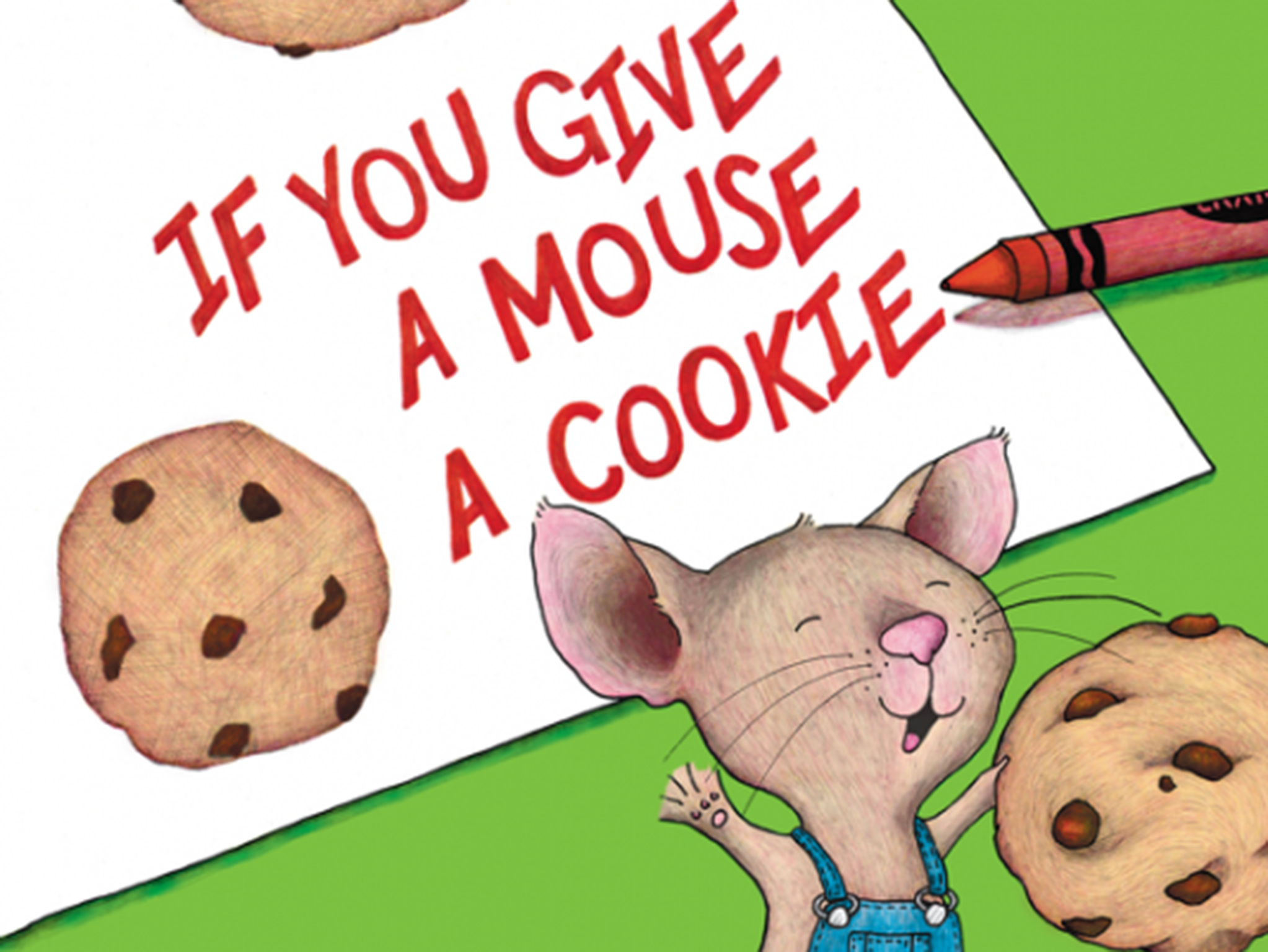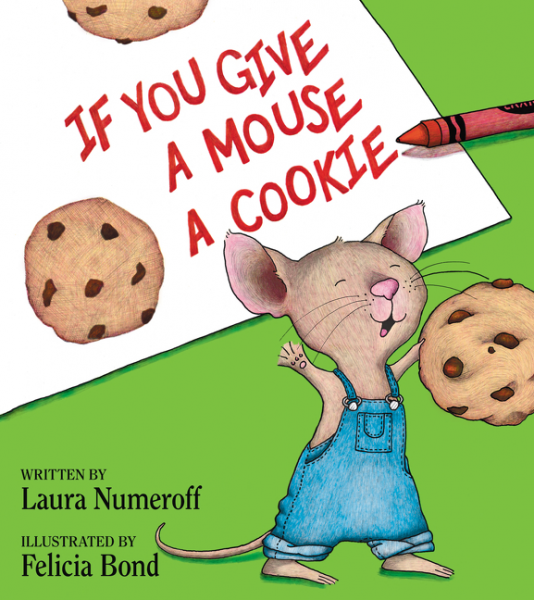The secret political message in 'If You Give a Mouse a Cookie'
The story takes the form of an ironic warning about the consequences of altruism

The books we give our children to read often reveal as much about our own concerns and obsessions as about theirs. Take “If You Give a Mouse a Cookie,” the children's book written by Laura Joffe Numeroff and illustrated by Felicia Bond. It's a story about charity and self-reliance first published 30 years ago, when the welfare system was at the top of the national agenda.
The story takes the form of an ironic warning about the consequences of altruism. Its facetious, nonsensical plot describes a mouse who becomes reliant on a boy to answer his needs.
If you give a mouse a cookie, the book explains, then he'll ask you for a glass of milk, and then a straw, and then a napkin — beginning a cycle of requests that doesn't end even when the book does. Among numerous sequels are “If You Give a Moose a Muffin” and “If You Give a Dog a Donut.” All told, the series has sold 45 million copies, according to the publisher, HarperCollins.
The tension in the book is familiar to anyone who has wondered if withholding help does more to encourage others to help themselves. Economists call it the “Samaritan's dilemma.” The relationship between the boy and the mouse could be that between a parent and a child, or — in the view of some conservative critics of the welfare system — between government and those who rely on it for support.
Other experts on poverty see this familiar critique of public welfare is too simplistic. There is no doubt that welfare discourages some recipients from working. In general, though, proponents of the system argue that beneficiaries want jobs to do and that their values and ambitions are similar to other Americans'.
In other words: If you give a mouse a cookie, most of the time, you're just giving a mouse a cookie.
In the book, of course, it's never just a cookie that the mouse wants. Next, it's a pair of scissors, a pillow, Scotch tape and on and on. Meanwhile, Bond's drawings show a boy who, worn out by the mouse's incessant requests, falls asleep in a rocking chair.
The book's lesson, self-sufficiency, was a subject of intense political debate at the time of its release in 1985. President Ronald Reagan and other conservative politicians warned that welfare would only encourage Americans to depend on the largess of government and would sap their willingness to work. Their children would learn by their example, becoming unmotivated, shiftless adults, a generation that never learned to provide for themselves. The cycle of poverty would perpetuate itself.

“There are plenty of people out there who would read this book and say, 'Boy, if you give a mouse a cookie, you're just creating huge dependency, and before you know it, he'll be taking a nap in your bed,'” said Ron Haskins, a former congressional staff director.
In the years following the book's publication, policymakers around the country began making changes to welfare programs. In 1992, President Bill Clinton campaigned successfully on a promise to “end welfare as we know it.”
That summer, welfare was the issue most frequently cited by Americans as the country's most important problem after crime and violence, according to a survey by Gallup.
It was Haskins who supervised the drafting of legislation that would overhaul the federal system, which Clinton signed in 1996. The bill established a limit on the amount of time a person could receive cash payments from the state and required recipients to work. It set up local programs to help beneficiaries seek employment and dedicated funding for child care so parents would have someone to look after their children while they were at work. As a result, more people joined the labor force.
The economy was doing well in those years, giving more people an opportunity to work, but economists believe that at least some of the increase was a result of the new law. A range of estimates produced by economists suggests that the country's welfare rolls were reduced by some 20 per cent and that employment increased by about 4 per cent as a result of the reform.
For Haskins, now at the Brookings Institution, these figures show that welfare had not created a culture of dependency. Public assistance hadn't fundamentally changed the values of poor Americans. If it had, he argued, the increase in payrolls would have been less dramatic, as recipients would have resisted the government's efforts to make them work.
Yet those receiving welfare did not seem to be opposed to the new program. Haskins cited a study by a group of researchers who conducted interviews with 80 families receiving welfare in Philadelphia and Cleveland after the reform. The recipients said they thought that the requirement to work was reasonable, that they wanted to educate themselves and that they were optimistic about their chances to improve their earnings.
“In general, the research on the extent to which welfare benefits induce dependency in people shows that it is certainly not a huge phenomenon,” Haskins said. “They do want to work.”
To be sure, public programs can discourage people from working. Between 1968 and 1980, the government conducted a series of experiments on tax refunds, in which participants received a refund if their incomes were below a certain threshold. The experimenters found that single mothers worked less in response to these payments. For each dollar they received in the form of a refund, they earned about 20 cents fewer on the job.
Recipients kept on working for the most part, and the payments left them much better off than they would have been otherwise. Yet because it discouraged them from working, the programs were more costly.
“Giving the mouse a cookie and giving the mouse a glass of milk isn't free,” said Michael Strain, an economist at the conservative American Enterprise Institute. “That has to come from the person who made the cookie and who bought the milk.”
As for programs in existence today, evidence suggests they have little effect on how much people work — either because they require recipients to participate in the labor force or because the benefits they offer are too small to be meaningful.
“There are very few welfare programs today which actually fit the stereotype of giving people support in return for doing nothing,” said Robert Moffitt, an economist at Johns Hopkins University. “They really don't exist anymore.”
Economists have found that food stamps and Medicaid, for instance, have no measurable effect on how much recipients work.
Some research suggests that Clinton's welfare reforms have changed the behaviours of poor families outside the workplace. For instance, preliminary data collected by the health economists Hope Corman of Rider University, Dhaval Dave of Bentley University and Nancy Reichman of Rutgers University suggests that Clinton's bill might have encouraged poor women to vote. Maybe participating in the work force has made them feel more connected to society in general.
Yet Clinton's bill, which generally did not allow adult recipients to count time spent in classrooms toward their requirements, reduced the number of unmarried mothers attending college by more than 20 per cent, the researchers found. Enrolment in other kinds of schooling declined as well, their research shows.
Then again, the three economists have found that women committed fewer property crimes and were hospitalized and arrested in connection with illegal drugs less frequently after the reforms — perhaps because working simply left them with less time for those activities.
Recent research by Moffitt and his colleagues suggests that reform has also encouraged more poor women to marry — a controversial goal shared by some supporters of welfare reform. Since it's easier for two parents to raise a family than one, the earlier program provided more generous benefits to single parents receiving welfare. If they married, they were effectively penalized.
Many experts on poverty have argued that marriage provides stability to a family, giving its members the financial and emotional resources needed to overcome poverty. Others contend that the evidence for this view is inconclusive and that whether you tie the knot is none of the government's business. Experts are still debating what effect, if any, Clinton's law had on, the structure of poor families.
The next generation
Corman, Dave and Reichman are now investigating what welfare reform has meant for children. If reform had substantially improved circumstances for households in the program, the children would probably be better off as well. Yet the women who left welfare after reform generally did not have much more money than they did before, economists have found. Their earnings, along with contributions from other members of their households who also began working, barely made up for the benefits they lost, as Moffitt of Johns Hopkins has written.
The question for researchers is whether, with total incomes in these families remaining nearly constant, making parents go to work helped their children or not. Maybe working improved parents' self-esteem and expanded their social circles, making growing up easier for the kids. Maybe the example of a parent with a job encouraged those young people to be more ambitious about their own futures.
On the other hand, with more women working, many children were left unsupervised, which could have negative consequences for them later in life, Reichman speculated.
There is some reason to believe that, perhaps, giving parents money without requiring them to work can help their children do better. Recent research on welfare programs in the early 20th century suggests that simply transferring money to poor families resulted in children who were healthier, better educated and who ultimately lived longer.
Another new study on cash transferred to American Indian families from casinos found that the payments — which were not conditional on means or on whether the parents were working — improved relationships between parents and children, who were better behaved.
Maybe when parents have time to spend with their children they have more opportunities to teach them values of independence and hard work.
That's another lesson of “If You Give a Mouse a Cookie.” After the mouse is finished cleaning, he is ready for a nap and asks the boy to read a story to him. Books not only teach children how to read but also what it means to be an adult who participates fully in society.
A moment later, of course, the mouse is on his feet again. This time, he's asking for crayons and paper.
Copyright: Washington Post
Join our commenting forum
Join thought-provoking conversations, follow other Independent readers and see their replies
Comments